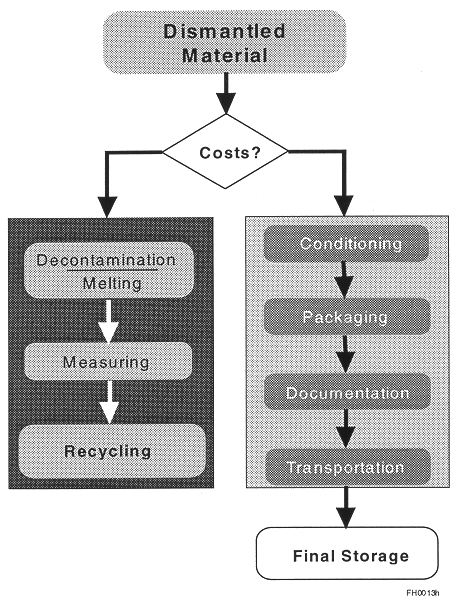
Fig. 1. Factors for waste management.
Dietrich Mertin
RWE Energie AG
Norbert
Eickelpasch
Versuchsatomkraftwerk Kahl
Helmut Steiner
Kernkraftwerke Gundremmingen
Detlef Schmidt
DETEC GmbH
ABSTRACT
The decommissioning of the first generation of nuclear reactors in Germany is underway since 1983 in the Gundremmingen Unit A plant (KRB A) and since 1988 in the pilot nuclear power plant in Kahl (VAK). Although they are both of the boiling water type, they are rather different to each other with reference to their size and construction. As the first German nuclear power plant at all, VAK had to serve mainly scientific purposes. KRB A was the first commercial reactor in Germany.
The actual work is the dismantling of high contaminated components inside the reactor building and the underwater cutting of activated internals of the RPV's. The decommissioning of KRB is foreseen to be finished before the year 2000, the work in VAK will end about three years later.
The experience made in both projects are not limited on dismantling work only, but also include know-how on costs, effective decontamination techniques and scrap recycling.
INTRODUCTION
The 250 MWe KRB A plant was in operation from 1966 to 1977. It was equipped with a secondary cycle with big recirculation pumps and three steam generators.
The 16 MWe plant VAK, which was shut down after 25 years of operation, used a separate secondary cycle for steam generation. Dismantling experience gained at KRB A and VAK are transferable to BWR's and PWR's as well.
The dismantling work in KRB A started in 1983 in the turbine house, which comprises about 4,500 tons of material with contamination up to 1,000 Bq/cm1.
Since 1990 the activities have been expanded to all primary water systems inside the reactor building. These are mainly the recirculation systems with the pumps and steam generators, and the cleanup and shutdown cooling systems, summarizing about 700 tons of material. The contamination of these systems was up to 50,000 Bq/cm2.
In 1992 work began on the activated components, the reactor pressure vessel (RVP) with its internals and the biological shield. This work is still underway.
Dismantling work in the VAK began in 1988. Presently the internals of the RPV are segmented with mechanical cutting tools and packaged with the RPV. Here, for the first time at all in Europe, the control rods of a BWR were cut under water.
Referring to the different design of VAK and KRB A, various tools have been developed and qualified to gain experience and compare the results from both projects.
MATERIAL FLOW AND DECONTAMINATION
In KRB A the dismantling work of contaminated and activated components will end up in about 6,000 tons of material. At the present time, more than 5,200 tons are already dismantled and treated generating only 7% of waste for final storage. Approximately 60% of the contaminated scrap could be cleaned for free release.
For this material, the following activity limits are valid by official German requirements:
About 33% of the steel parts with residual specific activities above 0.1 Bq/g and below 200 Bq/g (mainly pipes and valves with small diameters and materials with complicated geometry) were used for "nuclear recycling" by melting, which is a restricted rouse within the nuclear industry, i.e. producing shielding containers.
The extremely low limits for the free release of material require strong efforts with respect to decontamination and measurement techniques.
To realize the result shown above, one has to decide about the way of treatment of the dismantled components already at the very early stage. With respect to costs, all factors like conditioning and packaging as well as decontamination and documentation are taken into account to find the best and most economic way between recycling or preparing the material for final storage.

Fig. 1. Factors for waste management.
The actual experience of recycling 93% of about 5200 tons of dismantled material in KRB A and the consequent control of costs gives us the reason to prefer the way of recycling for contaminated materials in most cases.
In comparison to the costs for preparing the material for final storage, the savings in case of recycling are up to 70% for concrete, and even for high contaminated material, more than 30% of the costs can be saved.
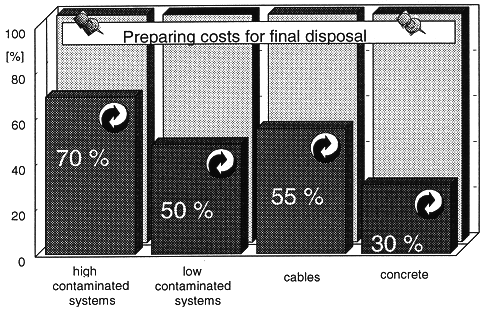
Fig. 2. Costs of recycling or
preparing material for final disposal (costs of final storage are excluded).
In order to minimize the costs for recycling, an effective decontamination procedure with phosphoric acid for disassembled steel parts was developed. The amount of low radioactive secondary waste in form of Fe-Oxide is only 1.5% of total mass for the rather low contaminated steel parts in the turbine hall.
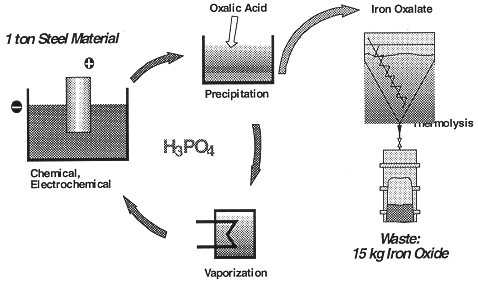
Fig. 3. Electrochemical
decontamination with phosphoric acid.
Most of the material of the water effected systems, i.e. the three steam generators, could be measured for free release after decontamination. On the whole, the low amount of waste in KRB A shows the successful application of the developed and optimized decontamination techniques and measuring procedures. Recycling of the phosphoric acid is developed and patented based on KRB A, also shown in figure 3.
The situation in VAK after the planned shut down was that all piping systems were in good condition, so first, a decontamination of the total primary cycle was possible with the CORD-process by Siemens-KWU. Especially in this plant, it was a very effective measure with respect to the related collective dose because of the extremely compact plant. The activity discharge was 6.3E-12 Bq, which was about 90% of the total contamination.
In Fig. 4 the collective dose is shown for the period of post-operation as well as the calculated difference between dismantling with and without the decontamination of the primary cycle up to the year 2000. The collective dose which can be saved is 2000 mSv at a minimum. This means that about 10,000 DM had to be spend for saving 10 man- mSv-a very reasonable account.
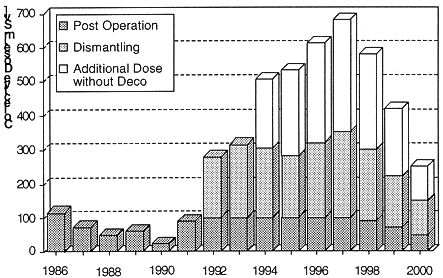
Fig. 4. Reduction of radiation by
decontamination of the primary circuit.
RECYCLING OF CONCRETE AND CABLES
Besides the electropolishing other cost effective recycling procedures were developed. The procedure mainly applied to concrete for example, is to keep the structure intact but clean the surfaces for subsequent free release. Concrete blocks with defined shape were treated with a special rotary grinder. After removing about 10 mm of the surface, the complete blocks could be measured for free release. Fractured concrete is homogenized by crushing techniques for mass specific activity measurement.
Electric cables from KRB A and VAK were shredded and the copper was separated from its insulation. It could be proven that 100% of the copper and even 70% of the insulation was free of contamination.
Another separation technique was developed for compound material, i.e. electro motors. Heating up the complete motors to the respective melting temperature of the material, aluminum, copper and steel can easily be separated. This technique is patented in KRB A.
DISMANTLING TECHNIQUES
Various tools and techniques have been developed and qualified in both plants, resulting in a cost effective decommissioning procedure. For demonstration purposes, a test basin was built in VAK allowing to prove the under water cutting and handling procedures in a 1:1 scale mock-up. The broad application of mechanical and thermal cutting techniques also helps to keep the dose uptake low. Some of the techniques are described below.
A typical task during decommissioning procedure is the segmenting of highly contaminated heat exchangers or steam generators of different size. For this purpose, KRB developed a new procedure, the "ice-sawing" technique, which is patented. The basic idea is to fill a heat exchanger with water and freeze the total component for subsequent segmenting with a special band saw, Fig. 5.
The application of the ice-sawing technique was demonstrated by segmenting three steam generators. The dimensions were 8.8 m in height and 2.2 m in diameter. A huge band saw was installed at the component at a vertical guide, so that slices with a height of 0.8 m have been produced. Ten cuts have been done at each steam generator. About 8 hours were needed for sawing of one segment.
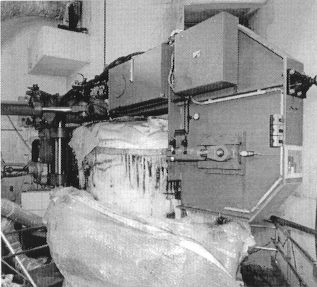
Fig. 5. Ice sawing technique.
The application of ice-sawing presents the following advantages:
Table I Dismantling Data of Three Steam Generators

Table I gives the main data and results gained from the dismantling of the three steam generators and points out the reduction of time and collective dose of the work from the first to the third steam generator. The ferritic steel parts could be decontaminated after post-segmenting from the high dose rate of about 20 mSv/h segmenting from the high dose rate of about 20 mSv/h in maximum for free release. Only the austenitic tube bundles were packaged after high pressure compaction into drums for final storage.
For segmenting the high contaminated Reactor Pressure Vessel, (RPV) internals, under water cutting techniques are available. Table I shows the data of some main components out of the RPV in KRB A.
Besides the application of mechanical cutting tools and hydraulic shears for thin walled pipes, the electro discharge machining (EDM) was used in VAK to cut the condensate sparger ring. A plasma torch of 100 kW output power is installed in KRB A at a special tool carrier which is mounted at a turn table in the steam dryer pool. This equipment allows to cut material up to a thickness of 100 mm. In the meantime, plasma arc cutting has successfully been used in a depth of 6 m for stainless steel with 80. mm thickness. The associated remote handling techniques have been in use successfully for several years now.
The first application of these tools was the dismantling of the steam dryer which is completed. Due to an additional suction device and an aerosol filtration, no radiological problems occurred for the operating staff. During cutting, the conditions of visibility did not get worse; also the specific activity of the water did not increase substantially.
Plasma are cutting under water is used with a special device. This device for instance is able to cut a pipe, as shown, in less than one minute, which is about 150 times faster than mechanical cutting. It is obvious that this will reduce the costs as well as the dose uptake of the personnel. Figure 6 shows a part of the water separator, presently being dismantled.
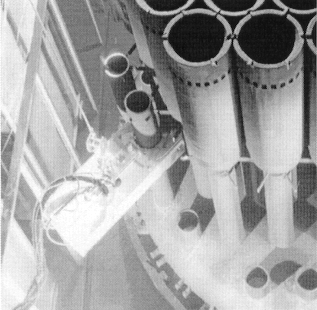
Fig. 6. Orbital plasma cutting device
for pipes.
Presently the dismantling of the condensate sparger ring, the grid plates and the core shroud is in preparation. Due to the good results in cutting the steam dryer, the water separator and the core shroud head, it is planned to use the plasma technique for the next components. Table II gives an overview of the activated RPV internals in KRB A.
Table II Activated Components in KRB A

Compared to the size of KRB A the VAK plant is compact and smaller. The use of small and easy-to-handle tools is required for the dismantling of the RPV internals, because the work has to be done within the RPV. The storage pool is located outside the reactor building.
Some specific data referring to the dismantling components in VAK are given in Table III
Table III Activated Components in VAK Kahl

Conventional mechanical cutting techniques were used in special applications to dismantle different internals. The sprinkler ring was cut into 24 pieces with the hack saw, which required about 100 man hours. One third of this work was used for preparation work. The dose uptake was less than 600 Sv. The main advantages of the hack saw are the high flexibility, the tool stiffness and the generation of large swarf particles, which causes no problems in visual observation under water.
The chimney above the core was cut by means of the hack saw and the nibbler. The nibbler could be guided by the same tool support as for the hack saw. Except the flange area which had to be cut by the hack saw because of its thickness of 25 mm, the whole dismantling of the chimney was performed by the nibbler. The tool had to be modified with respect to the under water handling and the shape of the chimney, but it turned out as a reliable tool with a high cutting speed. After 50 cuts through a material with a specific activity of 1.2 E08 Bq/g, the surface dose of the tool's head went up to 10 Sv/h, which was again less than expected.
A more difficult cutting task was the dismantling of the condensate sparger ring. Referring to its size and its position right beside the reactor vessel, conventional cutting tools could not be used. Different cutting techniques were tested in cold tests and finally the EDM (Electro Discharge Machining) was chosen to cut the ring into several angle sections.
CONCLUSION
Based to the experience at the KRB A and VAK plants, we are convinced that the decommission of nuclear power stations can be performed.
ACKNOWLEDGMENT
The work presented in this paper is partially supported by the European Community in the framework of the community research program on the decommissioning of nuclear installations.
REFERENCES